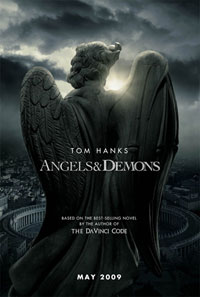| YOUR
FILM REVIEWS
(Reviews on this page do not necessarily represent the views of
Hollywood Math and Science Film Consulting.)

Review of Angels and Demons
by
Patricia Rankin
Professor
of Physics and Associate
Vice Chancellor for Faculty Diversity and Development
University
of Colorado at Boulder
(for identification purposes only)
Warning
– Spoilers ahead
It is hard not to like a movie which features CERN, antimatter,
Tom Hanks, and has a smart and attractive woman physicist as a
key character. Angels and Demons is fast-paced enough
that temporarily suspending judgment on the science while sitting
back and enjoying the entertainment is a pleasant way to spend
a couple of hours—
but how accurate is the science?
The
particle physics community has done a good job of getting out
the message that CERN is not a top secret facility and that, while
antimatter exists, the possibility of antimatter weapons is not
something to lose sleep over (see http://www.uslhc.us/Angels_Demons/resources.html
to link to lots of materials about CERN, the Large Hadron Collider,
and antimatter). Essentially matter and antimatter are produced
in equal amounts when energy is converted into mass (the favorite
equation E=mc2 governs this) and when antimatter comes into contact
with matter it annihilates (the movie gets it wrong when it says
antimatter “combusts”—
combustion is a chemical reaction involving a fuel and an oxidant)
producing energy. Antimatter is not produced from nothing so it
is not a solution to the energy crisis. You can use magnetic fields
to keep electrically charged particles of antimatter from coming
in contact with matter—
but the amount of antimatter needed to make a bomb capable of
destroying Vatican City would take many, many millions of years
to produce using today’s technology and could not be contained
for several hours in a small flask with magnetic fields powered
by a battery.
The
other big particle physics concept mentioned in the movie is the
“God Particle”—
known more prosaically as the Higgs boson. The Higgs boson is
indeed a particle that many particle physicists are hoping to
detect in their experiments when CERN’s LHC is turned on
(http://www.exploratorium.edu/origins/cern/ideas/higgs.html)
and it is the particle that holds the clue to why all the other
particles we know about have mass.
Personally,
I don’t have a problem with movie makers and/or Angels
and Demons author Dan Brown exaggerating the ease with which
antimatter can be made and stored to provide a plot element that
can drive a story. I am more concerned at some of the other liberties
with science and technology taken during the movie, which have
received less attention.
Let’s
look at the pivotal scene were the antimatter canister is recovered—
the cold temperature of the crypt has cut the battery lifetime
a couple of minutes, requiring a heroic helicopter flight to get
the antimatter high enough above Rome so that its detonation will
not cause massive destruction. Since batteries rely on chemical
reactions to work, their performance is affected by temperature,
and batteries operating at low temperatures produce less current
and work less well (conversely—
storing batteries at low temperature can increase their life).
Helicopters, however, are not designed to ascend rapidly (typical
rates of climb are around 2,500 feet/minute) and do not operate
at the high altitudes passenger planes typically fly at. Since
most helicopters operate below the height at which you can safely
parachute out (for experts this is set at about 2000 feet), I
do not know if parachutes are standard equipment on board—
but I am pretty sure that any deployed parachutes in the vicinity
of the shock wave of the antimatter/matter annihilation would
be destroyed.
In
another key scene Robert Langdon is trapped in a “hermetically-sealed
chamber” inside the Vatican Archives when the air supply
is turned off. There is a lot of bad science here. First, human
beings are not designed to transition rapidly between regions
of high pressure and low pressure (think about how slowly divers
are taught to ascend) and regions of low pressure and high pressure
do not rely on glass partitions to separate them (airplanes have
small windows for a reason). The “glass” was hard
to break though so maybe they used nano-composites (which do not
exist). Second, when the airflow was turned off (and you would
think there would be a safety interlock to prevent this) the people
inside the room would not feel the effects straight away and would
have some time before they used up the oxygen in the room. The
biggest problem though is that the rooms were designed to preserve
the manuscripts. If you wanted to stop the manuscripts from coming
into contact with oxygen, the best way would be to put them in
containers filled with an un-reactive or inert gas that would
not interact with them.
I
am also going to criticize the frequent references to the four
elements of science—
fire, water, air and earth—
because these are the four elements of Aristotle’s science,
not ours (though I loved the ambigrams). One of Galileo’s
most important achievements was to challenge the Aristotelian
worldview and highlight the importance of experiments in determining
how the world worked. The Periodic Table of Mendeleev (a great
site to explore is http://www.webelements.com/)
shows how more than a hundred elements can be grouped by their
properties and how these properties are in turn related to their
electronic structure. On a related note, Galileo probably used
parchment not papyrus.
I
want to finish though by going back to one of the things I did
like: this movie had an Italian woman physicist in it who did
not make this woman physicist cringe. I do not know if the producers
or the author know that Italy is one of the few Western countries
where women make up a substantial percentage of physicists. I
do know that physics is a great career for smart women!
<< Return
to Your Film Reviews
|